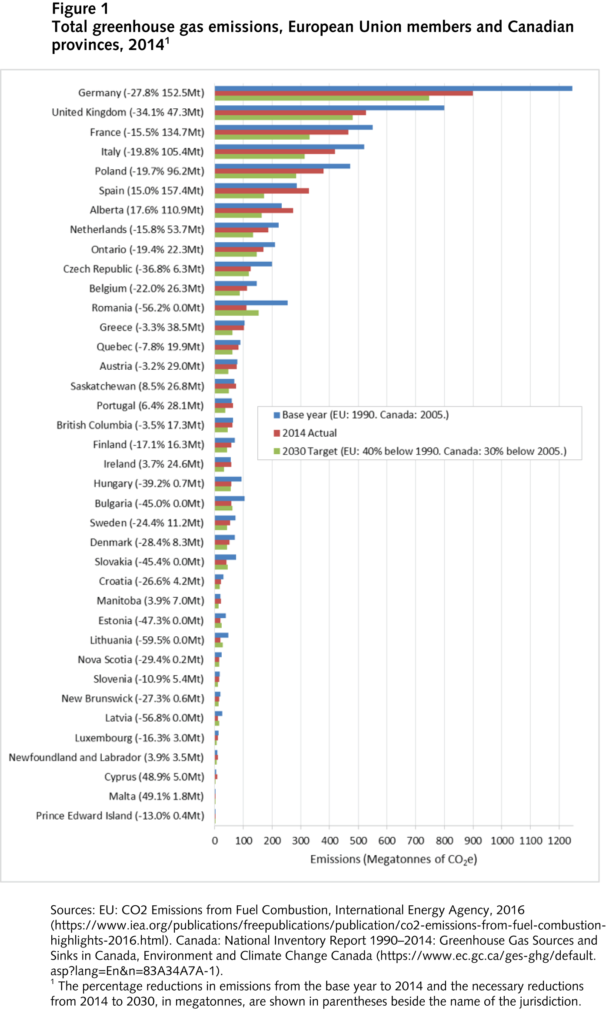
Last October, the European Union and Canada signed the Comprehensive Economic Trade Agreement (CETA). Shortly thereafter, in early November, both ratified the Paris Agreement on reducing greenhouse gas (GHG) emissions, committing them to achieving specific targets by 2030. Although these two agreements are not directly related, a less-discussed companion agreement to CETA, the Strategic Partnership Agreement, makes it clear that both the EU and Canada “recognise the global threat of climate change and the need to take immediate and further action to cut emissions in order to stabilise greenhouse gas concentrations in the atmosphere at a level that would prevent dangerous anthropogenic interference with the climate system.”
The Strategic Partnership Agreement is seen by the EU and Canada as a vehicle for two-way knowledge transfer and cooperation, allowing each to learn from the other. In this article we rank the EU member states and Canadian provinces in terms of their success at reducing greenhouse gas emissions and examine some of the issues they may be facing between now and 2030.
The EU’s first climate change policy was developed in 1991. Since then a number of policies have been introduced, such as the goal of reducing emissions in the EU by 20 percent by 2020. Currently, the EU has three main objectives for 2030:
- Reduce emissions to at least 40 percent below 1990 levels
- Increase the use of renewables in electrical generation to at least 27 percent
- Improve energy efficiency by at least 27 percent
The EU’s plan to reduce emissions is based on the following programs:
- The Emissions Trading System (ETS), an EU-wide cap-and-trade program. The ETS has proved to be less successful than expected, as several member states overestimated their emissions in order to protect their citizens and industries from the cost of purchasing emissions credits.
- The Effort Sharing Decision (EDS), a program that includes economic sectors not covered by the ETS (transport, buildings, agriculture and waste). Each member state is given an emissions-reduction target based on their GDP per capita. Member states have the freedom to form their own policies to reach their targets and set additional targets.
In Canada, prior to November 2016, most of the actions taken on climate change originated at the provincial rather than the federal level. Examples of successful provincial policies include British Columbia’s carbon tax, Ontario’s decision to stop using coal for electrical generation, and Quebec’s cap-and-trade system. In November, federal inaction on climate change ended with the Trudeau government’s decision to introduce a carbon levy on all provinces in 2018. The federal government considers the carbon levy essential if Canada is to meet its 2030 emissions reduction target of 30 percent below 2005 levels.
The total emissions for the EU and Canada are shown in table 1.
The progress made in reducing emissions by EU member-states and Canadian provinces is shown in figure 1, which lists the base-year emissions (1990 for the EU and 2005 for Canada), actual emissions in 2014, and 2030 targets.
For example, in 1990, emissions in the Netherlands were 222 megatonnes, by 2014 they had dropped by 53.7 megatonnes to about 187 megatonnes, and will need to decline another 54 megatonnes to reach the 2030 target of 133 megatonnes. Ontario’s emissions declined from 221 megatonnes in 2005 to 170 megatonnes in 2014, and must be reduced another 22.3 megatonnes if the 2030 target is to be achieved.
While most jurisdictions achieved some level of reduction from their base year by 2014, some, such as Bulgaria and Slovakia, have already met their 2030 targets, and others, such as Ireland and Saskatchewan, have increased their emissions.
Of the 28 member-states and 10 provinces, 2 member states and 2 provinces stand out for special consideration. At one extreme are Lithuania and Nova Scotia, which have achieved the greatest levels of emissions reductions between their base years and 2014. At the other are Germany and Alberta, which were the largest emitters of greenhouse gases in the EU and Canada in 2014.
In 1991, Lithuania declared its independence from a disintegrating Soviet Union. By the end of 1992, demand for Lithuania’s industrial output had declined sharply, energy supplies from Russia were curtailed, and Lithuania’s emissions had plummeted by 40 percent. By 1994, the country’s GDP had shrunk by almost 44 percent and did not return to its 1990 level until 2005, when Lithuania joined the EU. In 2014, its emissions were still less than two-thirds of what they were in 1990, despite the closure of its nuclear reactor (one of the requirements for Lithuania joining the EU) and an increase in the country’s use of natural gas. In addition, by 2014, demand for energy was less than half of what it was in 1990 and the population had declined by one-fifth. Lithuania’s impressive reduction in emissions was primarily the result of the disintegration of the Soviet Union rather than specific policies.
Between 2005 and 2014, Nova Scotia’s emissions declined by almost 30 percent. About half of these can be attributed to two factors, both associated with electricity supply: first, regulations were introduced requiring the provincial electricity supplier to make significant reductions in its use of coal and to increase its use of renewables and, second, a number of large, electrically intensive manufacturers closed down. The other half of the emissions reduction was the result of a series of unexpected events, notably, a decline in transportation energy demand, the closing of the provincial refinery, and changes in the way buildings are heated. During this period, there was little change in the province’s demographics (other than an aging population), and the economy remained one of the weakest in the country. Thus, a combination of policy and economic weakness was responsible for Nova Scotia’s significant decline in emissions.
By 2030, further changes in emissions are expected in Lithuania and Nova Scotia. As a former member of the Eastern Bloc, Lithuania is permitted, under the EDS, to increase its emissions by 10 percent, while Nova Scotia, although it has already achieved its 2030 target, plans to continue reducing its emissions to almost 50 percent below 2005 levels by 2030. Nevertheless, it is reasonable to assume that few jurisdictions would want to experience Lithuania’s economic decline in the 1990s and significant drop in population or Nova Scotia’s economic weakness and population stagnation in order to meet their reduction targets.
Unlike Lithuania and Nova Scotia’s experiences, which were somewhat similar, Germany and Alberta’s economic and social changes between the base years and 2014 differed considerably. Germany’s GDP grew by almost 40 percent, the result of industrial and manufacturing expansion, and its population increased only by about 2 percent. On the other hand, Alberta’s GDP grew by almost 33 percent and its population increased by almost 24 percent, a consequence of the rapid development of the oil sands. But even thought both their economies grew considerably, Germany’s emissions decreased by 24 percent, whereas Alberta’s emissions increased by slightly over 20 percent.
The decline in German emissions is largely the result of the policies to encourage energy efficient practices and the development of renewable technologies. Alberta’s reliance on the oil sands, coupled with weak emissions-reduction policies meant that its emissions continued to increase. Even with the emissions-reduction policies Alberta announced in 2015, emissions are expected to continue growing until the mid-2020s and then return to 2014 levels by 2030 (as opposed to reaching to the 2030 target).
While the Strategic Partnership Agreement may give Canada and the EU more scope for collaboration on meeting their Paris Agreement commitments, the EU has a number of advantages over Canada when it comes to emissions reduction: its economy does not rely on the export of carbon-based fuels and EU-wide emissions reduction policies are well established. Although some provinces have made progress towards reducing their emissions, Canada still faces considerable challenges; for example, the estimated reductions per person between 2014 and 2030 will be 1.7 tonnes in the EU and 5.9 tonnes in Canada.
This work was supported by the European Union and the European Union Centre of Excellence at Dalhousie University.
Photo: Lignite power plant in Neurath, Germany. r.classen/Shutterstock.com
Do you have something to say about the article you just read? Be part of the Policy Options discussion, and send in your own submission. Here is a link on how to do it. | Souhaitez-vous réagir à cet article ? Joignez-vous aux débats d’Options politiques et soumettez-nous votre texte en suivant ces directives.








